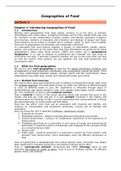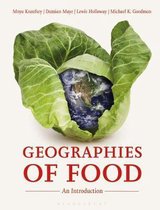Geographies of Food
Lecture 1
Chapter 1: Introducing Geographies of Food
1.1 Introduction
Nothing more geographical than food. Eating connects us to the land, to animals,
technologies and virtual space, ecological processes and to other people both near and
far. Connects us into relationships of power, politics, and identity, questions of agency
and structure, relations of inequality and (in)justice, and feelings of despair and hope.
Food networks can be simple or complex, fair or unequal, “good” or “bad”, local or global.
Food and its geographies are intimately and inseparably connected.
To understand how food stitches together a mosaic of materialities, people, places,
spaces, and scales-and at the same time how food themselves are produced by these
geographies-it takes what David Harvey (1990) and others call a geographical
imagination. It is vital in helping us understand and interpret the vast array of
information and data. It provides a powerful window, not just on who eats what, but also
on how the world’s food systems are put together and why food production and
consumption work.
1.2 What are food geographies
We use the term food geographies to describe the spatial distribution, patterns, and
arrangements of food production, distribution, and consumption around the world. There
are many relationships between people, animals, plants and the environment. These
relationships have often been uneven and infused with power and control.
1.2.1 Multiple food meanings
We need to think about food beyond its role in fulfilling a fundamental human need. Food
has multiple meanings. The same plate of food can taste very different to different people
or even at different times in your life. Experience is refracted through place of
birth/childhood, age, family situation, class, race, gender, body shape, health conditions,
etc. This multiplicity of food is called material semiotic.
Food is material in terms of the actual, physical plants and animals that grow or are
reared, and that you cook and eat. It is also semiotic (involved in the making and
communication of meaning) so that it can be represented and representational in things
like advertisements, on social media and food labels.
Food also has affect, more than just an association with meaning and identity, and
implying an inexpressible and sometimes profoundly moving set of feelings and
sensations.
José Luis Vivero Pol (2017) identifies 6 different “dimensions of food”:
1. Essential for humans
2. Renewable resource – based on domesticated and wild plants and animals.
3. Cultural determinant – eating is of fundamental importance to the experience of
being human.
4. Tradeable good (food as a commodity root cause of hunger and environmental
destruction. It presents a direct contradiction and challenge to the concept of food
as a universal human right)
5. Human right
6. Public good – would be governed in a polycentric manner by “food citizens” who
develop “food democracies” which adequately value the different dimensions of
food.
Food is transformed in geographically and culture-specific ways. Innovation has always
been significant to changing production-consumption relations and to diets.
Food is “ontologically multiple” (Annemarie Mol 2008). Ontology refers to and
describes the nature of reality or being. Food is part of multiple realities for different
people, times, and contexts.
,1.2.2 Food, place, space, and scale
Food doesn’t just move across space and between places: it plays a role in making
geographies.
Space is not just a surface upon which things can be located, it is continually produced or
made by circulations of and interrelationships amongst different people, goods and
cultures.
Food’s mobilities and transformations act to make geographies, sometimes sustaining
spatial relationships and place identities, sometimes changing them. Place is one of the
most important and central lenses to understand geographies of food.
Capturing relationships and relationalities is fundamental to understand food’s
geographies. On top of that an important geographical concept is scale, especially the
relationalities of scale: how and in what ways is food both intimate, personal, and
individual as well as ‘global’ in the transnational food networks. How are the global scale
processes of the food system relational to what we eat every day? Food is glocal in that
it has embedded within it the relational scales of local and global and everything in
between. There is also politics of scale.
Food’s places are connected to or disconnected from other places across space: food
chains, networks and systems.
1.2.3 Mobilities and transformation: power and control
Food, in order to become food, must move and be transformed, simple or complex.
Movements and transformations are associated with the movement of money, and the
accumulation of financial value, as food is processed, branded, and sold in various ways.
Consumption involves further rounds of transformation. Work, or labor, is involved during
movements and transformation. Work is undertaken primarily by women.
Conceptual diagram of the food system.
,The processes whereby food is moved and transformed involve power relations operating
at different scales, across different spatial and temporal dimensions. Majority World vs
Minority World. Majority World is Asia, Africa Arabic-speaking world, Latin America,
Caribbean and Indigenous people, most people living in poverty. Minority World is
inhabited largely by white, wealthy, urbanized, industrialized peoples who constitute a
small fraction of the world population.
Most obvious way in which contemporary patterns of food mobility and transformation
was established was through the Atlantic slave trade. This brutal interaction between
Minority and Majority Worlds has shaped food geographies that we observe today.
Between 1532 and 1832, around 12 million people from West and Central Africa were
shipped to the Americas, mainly to work on sugar, rice, cotton, and coffee plantations.
This made slave traders, commodity traders, landowners and Western European
governments rich. Food was at the heart of untold stories and historic relationships
between peoples and continents, and the patterns in trade, landscapes, food cultures,
geopolitical relations, and identities which were established during the era of Atlantic
slavery and are still present.
Carney (2001) reveals how the enslaved Africans brought their long-crafted knowledge
systems – as well as their physical labor – to the production of rice.
Kloppenberg (1991) argued that Western science produced an unsustainable and socially
damaging agriculture. An “alternative” perspective based on farmers’ localizezd,
experiential, and working knowledges of their own farms would be more likely to lead to
sustainable agriculture.
Vandana Shiva is one of the most influential writers on food and environmental justice.
Drawn attention to the ways in which Western science ignored or appropriated traditional
expertise and skills, and to how this was a highly gendered process. Women have been
central to agriculture. Women produce over half of the world’s food and provide more
than 80 percent of food needs in food-insecure households.
1.3 Geographical imaginations and food’s geographies
What we have not discussed yet is the particular ways in which Geography, as an
academic discipline, with a particular history, concepts, and methodologies, has
contributed to the patterns and processes that we’ve been describing.
Geography is “essentially a European branch of knowledge, reflecting European
ways of making sense of the world”. Through their cartographic, descriptive, and
analytical skills, geographers provided empire builders and colonialists with valuable
information about the resources, climate, infrastructure, and foodstuffs found in foreign
lands which were then exploited, mined, farmed, and traded very often to the detriment
of the livelihoods of local people. Cartographers imposed names for places for
“empty/undiscovered” land, while the indigenous population already had a name for the
place. The boundaries imposed by imperial geographers were used to enclose and defend
precious natural resources which could then be exploited for the benefit of settler
colonies and the European nations.
Scholars show that this colonial mindset considered all parts of nature, animals and the
bodies of the indigenous people as resources to accumulate wealth.
Critique on the limitations of this kind of geographical imagination:
postcolonialism is contested term because it is unclear that colonialism has been
regulated (verbannen) to the past. “There is nothing ‘former’ or ‘post’ about the
colonialism that they write about: they are writing out of and about the continuous
colonization and re- (or neo) colonization of the countries where their ancestors have
always lived.”
Thinking about postcolonialism and decolonialism is important for our thinking about food
geographies, not only because it helps us understand the historic roots of contemporary
structures, injustices, and often hidden traumas, but it also opens up our minds towards
very different ways of thinking about the meaning of food, and the relationships of
humans to each other and to the myriad life forms with which we share the planet.
, Lecture 2
Hanink, D.M. A companion to economic geography – Resources
Natural resources are “factors of production.” They are employed along with labor and
other forms of capital in producing goods and services. Economic geography of natural
resources, places of their production and places of their consumption, is fundamentally
different from the economic geography of most other production factors. Natural
resources exist as a form of interaction between the physical environment (nature) and
society.
Defining and Classifying Natural Resources
Zimmerman: “resources are not; they become.” resources are not pre-given, natural
factors around which society fashions its productions processes, but rather their
usefulness is conditioned by cultural, historical, technological, and geographical
circumstances. Almost all mineral resources have a technological context to their value.
Changing societal contexts affect the recognition of mineral resources.
Once natural resources are recognized as factors of production, they are often described
by their supply characteristics. Example: exhaustible or renewable. Exhaustible: fixed
terrestrial or oceanographic supply and will be completely consumed if current rates of
use continue. Renewable: not in such fixed supply. May be biotic or astrophysical. The
amount of a resource is also classified into a series of components.
1. Cumulative production: the amount of the resource that has already been
extracted and is no longer available
2. Reserves: the amount of the resource that is available using current technology
and at current prices.
3. Potential supply: an effective estimate of future reserves. The amount of resource
that will be available if reasonable expectations of technological advance are
achieved and/or prices increase.
Recoverable resource is combination of reserves and potential supply. Rests on a
technological context and a context of market preferences.
In addition to technological and market contexts, there is also the geographical one. Most
regional production increases until about one-half of its recoverable resource has been
extracted: it peaks at that point, and then begins a decline. The geographical pattern of
recognition – core regions early, peripheral regions late – is common to a large variety of
natural resources. Though supply declines, consumption does not necessarily follow the
same pattern.
Location of resource deposits is almost irrelevant to where geographically those
resources will be used. Result of historical importance of the cultural, technological, and
market contexts for resource recognition.
Economic Rent and the Exploitation of Natural Resources
One of the most influential economists to examine resource exploitation: David Ricardo,
early 19th century. Most interested in the relationship between crop prices and land
prices. Generally held view was that price of food was high because agricultural land was
so expensive. High prices to cover land rent. Ricardo showed different. As food prices
rose, farmers expanded their production through more intensive cultivation and by
expanding crop production to land previously left unused for cropping. More and more
land could be expected to undergo development for agriculture. As prices rose,
agricultural land “became” more and more a natural resource.
Not all land is suitable for agriculture. Qualitative differences in land as a result of
differential soil fertility or irrigation requirements had an important bearing on the profits
generated from farming. Ricardo analyzed variations in land profitability in terms of
economic rent, payment over and above what is necessary to stay in business. Rent is
defined by: R = Q x (p – c)
R = economic rent, Q = quantity of production (kilograms for example), p = price per unit
(kilo) paid in the marketplace, c = cost per unit (kilo) of production. If R is positive, then
farmer can pursue agriculture on it.





